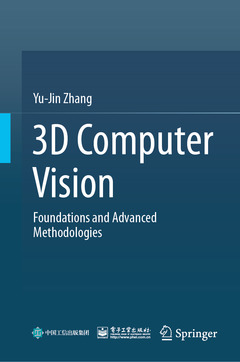3D Computer Vision, 1st ed. 2024 Foundations and Advanced Methodologies
Auteur : Zhang Yu-Jin

This book offers a comprehensive and unbiased introduction to 3D Computer Vision, ranging from its foundations and essential principles to advanced methodologies and technologies. Divided into 11 chapters, it covers the main workflow of 3D computer vision as follows: camera imaging and calibration models; various modes and means of 3D image acquisition; binocular, trinocular and multi-ocular stereo vision matching techniques; monocular single-image and multi-image scene restoration methods; point cloud data processing and modeling; simultaneous location and mapping; generalized image and scene matching; and understanding spatial-temporal behavior.
Each topic is addressed in a uniform manner: the dedicated chapter first covers the essential concepts and basic principles before presenting a selection of typical, specific methods and practical techniques. In turn, it introduces readers to the most important recent developments, especially in the last three years. This approach allows them to quickly familiarize themselves with the subject, implement the techniques discussed, and design or improve their own methods for specific applications. The book can be used as a textbook for graduate courses in computer science, computer engineering, electrical engineering, data science, and related subjects. It also offers a valuable reference guide for researchers and practitioners alike.
Chapter 1 Introduction
1.1 Introduction to Computer Vision
1.2 Computer Vision Theory and Framework
1.3 Introduction to Image Engineering
1.4 Introduction to Deep Learning
1.5 Organization and Content of This Book
Chapter 2 Camera Imaging and Calibration
2.1 Lightness Imaging Model
2.2 Space Imaging Model
2.3 Camera Calibration Model
2.4 Camera Calibration Methods
Chapter 3 Depth Image Acquisition
3.1 Depth Image and Depth Imaging
3.2 Direct Depth Imaging
3.3 Indirect Depth Imaging
3.4 Single-Pixel Depth Imaging
3.5 Biocular Vision and Stereopsis Vision
Chapter 4 Binocular Stereo Vision
4.1 Region-Based Binocular Stereo Matching
4.2 Feature-Based Binocular Stereo Matching
4.3 Parallax Map Error Detection and Correction
4.4 Stereo Matching Based on Deep Learning
Chapter 5 Multi-Ocular Stereo Vision
5.1 Horizontal Multi-Ocular Stereo Matching
5.2 Orthogonal Trinocular Stereo Matching5.3 Multi-Ocular Stereo Matching
5.4 Equal Baseline Multiple Camera Set5.5 Single Camera Multi-Mirror Catadioptric System
Chapter 6 Monocular Multi-Image Scene Restoration6.1 Monocular Image Scene Restoration
6.2 Shape from Illumination
6.3 Shape from Motion
6.4 Shape from Segmented Contour
6.5 Photometric Stereo Review
6.6 GAN-Based Photometric Stereo
Chapter 7 Monocular Single-Image Scene Restoration
7.1 Shape from Shading
7.2 Shape from Texture
7.3 Shape from Focus
7.4 Estimating Pose from Perspective Three-Point
7.5 Shape from Shading in Hybrid Surface Perspective Projection
Chapter 8 Point Cloud Data Processing
8.1 Point Cloud Data Overview
8.2 Point Cloud Data Preprocessing
8.3 Laser Point Cloud 3D Modeling
8.4 Texture Mapping for 3D Models
8.5 Point Cloud Feature Description
8.6 Point Cloud Understanding and Deep Learning
8.7 Bionic Optimized Registration of Point Clouds
Chapter 9 Simultaneous Location and Mapping
9.1 SLAM Overview
9.2 Laser SLAM Algorithms
9.3 Visual SLAM Algorithms
9.4 Swarm Robots and Swarm SLAM
9.5 Some New Trends of SLAM
Chapter 10 Generalized Matching
10.1 Introduction to Matching
10.2 Object Matching
10.3 Dynamic Pattern Matching
10.4 Matching and Registration
10.5 Relationship Matching
10.6 Graph Isomorphism Matching
10.7 Labelling and Matching of Line Drawing
10.8 Multimodal Image Matching
Chapter 11 Understanding of Spatial-Temporal Behavior
11.1 Spatial-Temporal Technology11.2 Action Classification and Recognition
11.3 Subject and Action Joint Modeling
11.4 Activity and Behavior Modeling
11.5 Abnormal Event Detection
Yu-Jin ZHANG received his Ph.D. in Applied Science from the State University of Liège, Belgium, in 1989. From 1989 to 1993, he was a post-doctoral fellow and research fellow at the Delft University of Technology, the Netherlands. In 1993, he joined the Department of Electronic Engineering, Tsinghua University, Beijing, China, where he has been a professor (since 1997) and tenured professor (since 2014) of Image Engineering.
Actively engaged in image engineering education and research, he has published more than 500 research papers and more than 50 books, including the series of textbooks "Image Engineering (I): Image Processing," "Image Engineering (II): Image Analysis," "Image Engineering (III): Image Understanding" and "Image Engineering (bound volume)" (1st, 2nd, 3rd, and 4th editions); three monographs: "Image Segmentation," "Content-based Visual Information Retrieval" and "Subspace-based Face Recognition," and one dictionary: "An English-Chinese Dictionary of Image Engineering" (1st, 2nd, and 3rd editions), as well as three edited books: "Advances in Image and Video Segmentation," "Semantic-Based Visual Information Retrieval" and "Advances in Face Image Analysis: Techniques and Technologies."He is the honorary chairman of supervisors (2020 to present) of the China Society of Image and Graphics (CSIG), and one of first Fellow members of the China Society of Image and Graphics (since 2019). He is the current or former deputy editor-in-chief of "Journal of Image and Graphics" and associate editor of "Acta Automatica Sinica," "International Journal of Image and Graphics," "Journal of CAD and Computer Graphics," "Journal of Electronics and Information," "Optical Engineering," "Pattern Recognition Letters" and "Signal Processing." He was the program chair of the First, Second, Fourth, Fifth, Sixth, Seventh and Eighth International Conference on Image and Graphics (ICIG'2000
Presents a comprehensive overview of 3D computer vision, ranging from its foundations to advanced methodologies
Offers a self-contained reference book suitable for researchers in the areas of computer vision, etc
Written by a respected author and leading expert in the field
Date de parution : 05-2024
Ouvrage de 537 p.
15.5x23.5 cm
Disponible chez l'éditeur (délai d'approvisionnement : 15 jours).
Prix indicatif 179,34 €
Ajouter au panier